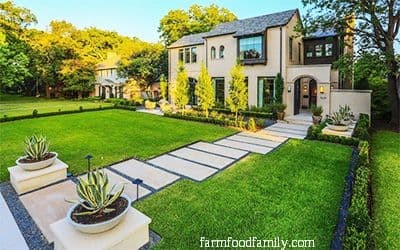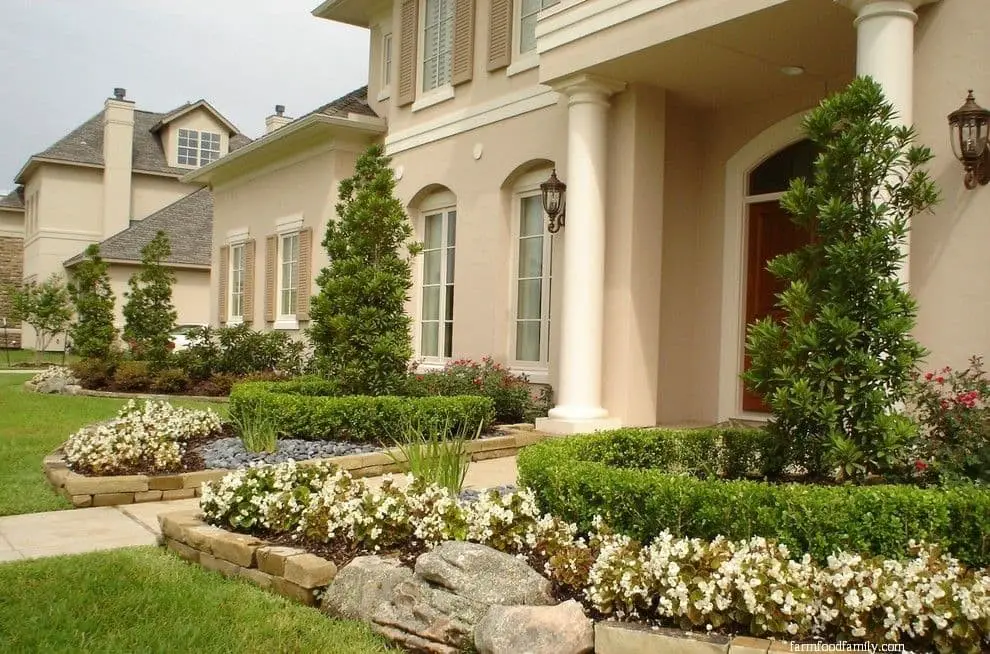20+ Best Texas Landscaping Ideas And Designs
Texas, the Lone Star State, is a vast region with diverse weather conditions across its various regions. While winters can be mild or even cold, summers are often hot and arid. This unique climate presents a challenge when envisioning what Texas landscaping might look like, whether you’re trying to imagine a new design or upgrade your existing one.
If you’re curious about the different landscape styles that thrive in Texas’s distinct regions, we’ll explore some of the most striking yet practical ideas for each area in this article.
North Texas landscaping ideas


In North Texas, where Dallas and southern Oklahoma converge, the balance between suburban sprawl and metropolitan grandeur creates a unique landscape canvas. With colder winters and more temperate summers, this region benefits from vibrant green turfs, colorful blooms, and the striking presence of trees like Chinquapin oak, shrubs, and vines such as juniper. The area’s distinctive aesthetic is defined by its use of light tones and earthy hues.
In Dallas, a stunning upscale property leverages its sloping terrain to create a sleek concrete stair that leads directly to the front door. Minimal yet deliberate plantings serve as accent pieces and borders for the expansive grass turf, while warm lighting at the stairs adds an air of sophistication. The overall effect is one of refined elegance.
In Fort Worth, a perfectly balanced blend of dense shrubs and fine-grass turfs creates a breathtaking entrance view that complements this brick stone house. The striking contrast between these elements and the earthy tone of the dwelling produces a landscape that is at once beautiful and harmonious.
Central Texas landscaping ideas


In Central Texas, where the three largest cities of the state – Dallas, Houston, and San Antonio – converge, a unique landscape beckons. The region’s natural elevation and hilly terrain create an ideal setting for xeriscaping, which thrives in this environment. A blend of hardy plants and succulents, or tree and shrub-based landscapes featuring juniper, jasmine, and Hawthorne, can be particularly effective when situated near lakes, a common feature of Central Texas.
The result is a cacti-filled wonderland that transitions seamlessly into native landscaping. By incorporating clay soil, minimizing ground cover, and showcasing native plants, this design achieves a dense yet alluring appearance. The succulents’ vibrant colors create an intriguing visual display. A well-organized landscape unfolds, with flowering plants positioned at the walkway’s entrance and rounded off by a grass focal point.
Edges are defined by densely arranged shrubs, providing bright borders that add depth to the area.
Houston landscaping ideas


Houston’s harsh summers, torrential rains, and clay soils pose significant challenges for landscaping in the city. To mitigate these issues, consider incorporating low-maintenance elements into your design. Hardscapes, such as walkways and stone planters, can provide a sturdy foundation, while bright groundcovers, artificial grass turf, perennials, and evergreen trees can add visual interest without requiring excessive upkeep.
One approach to Houston landscaping is to create a series of smaller walkways that branch off from a larger path. This design feature allows for the placement of well-curated bright flowering perennials above-ground on stone planters, adding a touch of elegance. The incorporation of dwarf palmettos on the sides adds a subtle yet refined element. Another option is to opt for a classier look by incorporating Bermuda grass, hardscapes, and trimmed shrubs around an enclosed area.
While this design may require some maintenance to keep the turf in good condition, it can still be considered a low-maintenance Houston front landscape overall.
Pool landscaping ideas


Texas’s arid summers necessitate clever incorporation of water features, like pools, into hardscapes. A thoughtfully designed pool can be a game-changer for hot summer days. Take, for instance, this vibrant example featuring an above-ground twisty pool as its centerpiece. The surrounding landscape is carefully crafted to complement the pool’s visual appeal, with flagstones and concrete pavers creating a visually appealing contrast.
The addition of flowering plants adds a pop of color, making it a true oasis. In Houston, remodeled pool landscaping can be taken to new heights by incorporating wooden elements that impart a sense of lightness and refreshment. Strategically placed towers of shrubs and trees provide natural shade, further enhancing the area’s coolness.
Texas landscaping ideas for small yards

In Texas, where space can be at a premium, crafting a charming outdoor oasis in a compact yard requires clever planning and design. Dense plantings of grass, shrubs, and other greenery can work wonders in creating visual interest. A thoughtful selection of stone edges and wooden planters can further enhance the curb appeal of your small Texas yard. Take inspiration from this stylish Austin abode, where above-ground stone planters add a unique twist to the stamped concrete patio.
The addition of pea gravel, solar-powered garden lights, and lush shrubs creates a warm and inviting ambiance. Meanwhile, an elevated patio with cozy seating and a reading nook near the shed proves that even the smallest yards can be transformed into a tranquil retreat. The pièce de résistance? A vibrant display of bright flowers and medium-sized shrubs brings the whole design to life.
Texas drought tolerant landscaping ideas

To create a drought-tolerant landscape in your Texas home, you’ll need to incorporate succulents and hardy plants on a larger scale. Complementing these with hardscape elements like stones and concrete can also serve as a striking focal point. However, it’s not necessary to have an all-succulent yard. By cleverly angling your landscape, you can create sections that feature succulent spreads. This approach allows for visual interest without overwhelming the space.
For a more compact yard, consider setting up raised planters and using them to display large cacti as the centerpiece. You can then surround these with bright-colored plants and stones, creating a visually appealing design.
Texas landscape design guide
When it comes to landscaping design, there are specific considerations that must be taken into account. The terrain, climate, and general topography of your property all play a crucial role in determining the right approach. This includes allocating sufficient space for trees, shrubs, and other features, as well as selecting plants that thrive in these conditions. For instance, if you live near roads, it’s essential to prioritize noise reduction through strategic plant placement.
Additionally, being mindful of native plant species and designating non-mow zones are also important factors to consider. By taking a thoughtful and tailored approach to your landscaping design, you can create a beautiful and functional outdoor space that complements your home.
Conclusion
When it comes to landscaping in Texas, the key challenge lies not in what you do with the terrain, but rather in selecting the right plants for your specific region. While hardscapes and basic xeriscaping can provide a solid foundation, there’s nothing quite like incorporating hardy plants and shrubs that thrive in the Lone Star State.
By considering various design ideas and taking into account the unique characteristics of your property – including its vulnerabilities – you’ll be well on your way to creating a truly remarkable outdoor space.






